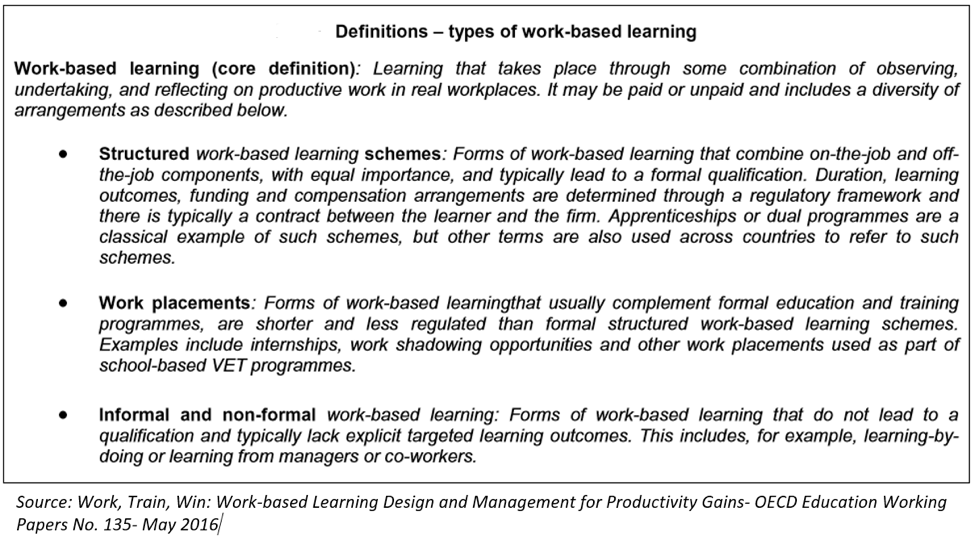There exist different kinds of work-based models lasting from weeks to years to suit varying needs of employers, the intensity of skills training, youth aspiration, assessment and certification, government support, and regulation. The potential for work-based learning in aiding youth to acquire skills that enhance employability and ease the transition from school to work is backed by strong international cross-country studies.


Apprenticeships are but one of the various learning-by-doing methods, and a proven method central to addressing labour market imbalances. In the Indian context, apprenticeships are increasingly gaining importance in national agendas and with the right mechanisms in place can well become the proverbial silver bullet, to make sweeping changes to the gaping issue of youth unemployment.
The current Indian education system is heavily weighed down by archaic rote learning methods leading to conventional degrees which are often mismatched with industry demand. Reluctance to accept the benefits of work-based learning such as apprenticeships must give way to spur workplaces to become temples of skilling. Union Minister Anantkumar Hegde in 2018 referred to ‘unemployability’ as the greatest stumbling block to India’s growth. We can see why, with an estimated 5 million graduates out of work at any given point. India has its work cut out with an insignificant 4%-5% of the workforce with formal vocational skills[i], and 75%–90% of the 50–70 million new jobs up to just last year in need of some form of TVET education.[ii]
What are the benefits of apprenticeships as a model of work-based learning?
- An individual is immersed in real-world work acquiring meaningful skills that augment their job-readiness for entry or advancement along a particular career path.
- Dropout rate from formal education in India peaks at the secondary level (class IX-X at 17%, as compared to 4% in elementary school and 2% in upper secondary school (class XI-XII).[iii] Bringing school drop-outs into apprenticeship training is akin to throwing a life-line to thousands of youth otherwise disenfranchised from education or work.
- An apprenticeship is at its most powerful when the experience follows a structured continuum of a sequence of highly focused competencies aligned with specific industries and occupations. This allows trainees to acquire skills and enjoy what they do in the context of real work. As aptly put by Rajesh Aggarwal, Joint Secretary, Ministry of Skill Development and Entrepreneurship, in his keynote address at a recent NETAP-IAF event “If someone comes through a shop-floor hand holding experience and gets familiar with the work environment, they tend to get wedded to the organisation.”
- Merely skilling is an inadequate strategy if it does not consider an individual’s career aspirations. Apprenticeships allow progression in an experiential work-based learning environment where trainees develop a strong sense of career options. Organisations have found that retention is much higher with employees from an apprenticeship route compared with someone who comes without shop floor training and is disconnected. Joint Secretary Rajesh Agarwal enunciated this by stating, “I do not see how apprenticeships are not a win-win situation for both industry and trainees. A work immersed environment makes youth aware if that job is meant for them. If it is meant for them they will go through the process whereby they have acquired the skills and have proven their loyalty to the sector. So youth become just right for that sector.
- Yet another key advantage of apprentices as a work-based learning model tilting the argument in their favour is that apprenticeships are highly responsive to labour market change. It stands to reason that employers will offer apprenticeships in accordance with their business needs in specific occupations in a particular sector; resulting in a demand-pull model in supply chain matching of sought-after skills at the apprenticeship stage itself. This talent matching towards career advancement through apprenticeships holds particular significance in the Indian context where loosely, India Inc. and industry research have conveyed that 65-75% of Indian youth entering the workforce are unemployable as their skills are just not right for existing jobs.[iv]
- The National Skills Qualification Framework (NSQF) aims to become a nationally integrated education and competency based skills framework traversing multiple pathways within vocational education, vocational training and general education. And it includes apprenticeships. Efforts are underway to anchor the NSQF into work-based training curricula which will amp the value of apprenticeships as a stepping stone into the labour market. Apprenticeships will be duly recognised as a credible competency-based qualification for an occupation, obtained through work-based skills training and valid across workplaces in the same or allied sectors. An industry-recognised work-based credential which certifies the possession of a full set of knowledge, skills and competences to perform that occupation is a powerful testament to the promise of apprenticeships to gain employability skills.
To sum up, stepping out of the classroom and into work-based learning such as apprenticeships open career doors for youth and allow employers to take the helm in guiding exactly which skills (both technical and soft) their future employees need.
References
[i] MSDE Annual Skill Report 2016-17
[ii] Knowledge Paper On Skill Development in India Learner First, 2012- FICCI, Ernst & Young
[iii] Educational Statistics at a Glance, 2018, Department of School Education & Literacy, MoHRD
[iv] Bridging the skills gap: Less than 5% of workforce in India has undergone formal skill training, Jul 3 2018, Counterview














